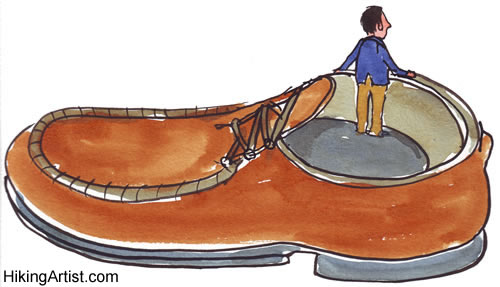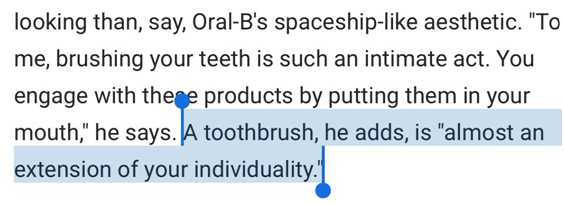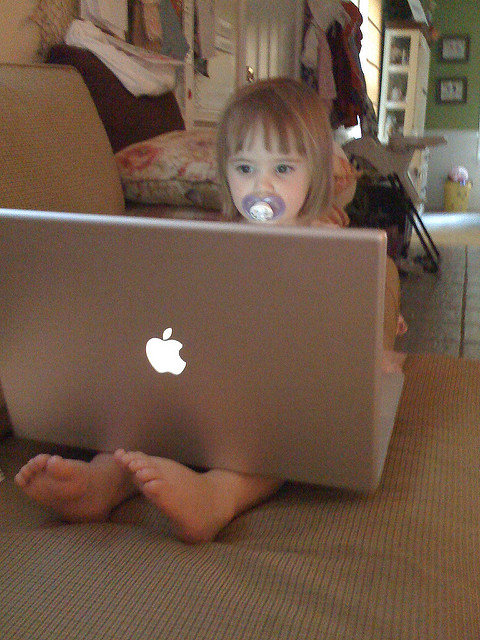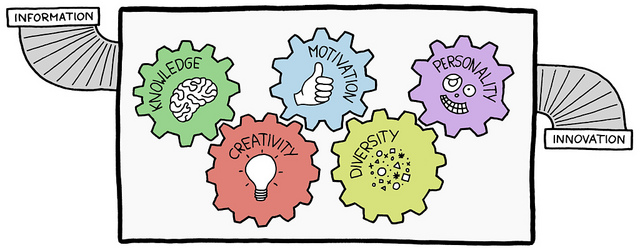|
|
|
Archive for the 'Innovation' Category
Friday, May 11th, 2018

A Friday series exploring Startups and the people who make them go. Read all If the Shoe Fits posts here.
As I keep saying, I do love CB Insights daily newsletter. It provides me with needed information, but my love stems from Anand Sanwal’s quirky, irreverent, incisive comments, like this one.
I now see toothbrushes in a whole new light after this comment by the founder of a subscription-as-a-service toothbrush company.

Does this guy actually believe that something (AKA a toothbrush) that has no wheels, software or circuits can substitute as an “extension of personality?”
The only “change the world” ethos I can find here is greed coupled with the ability to sucker people who are either too lazy, too incompetent or too busy on social media to take care of their basic necessities.
Good grief, is this the best the vaunted Silicon Valley innovation machine can produce?
Image credit: HikingArtist
Posted in Entrepreneurs, If the Shoe Fits, Innovation | No Comments »
Monday, April 16th, 2018

Poking through 11+ years of posts I find information that’s as useful now as when it was written.
Golden Oldies is a collection of the most relevant and timeless posts during that time.
This post is from 2014. Study after study has proven that more successful founders are in their 40s and 50 than in their 20s. More on the most recent studies this week.
Read other Golden Oldies here.
On one hand you have Jim Goetz, partner at Sequoia Capital, lamenting the lack of enterprise startups and on the other you have Sequoia’s Michael Moritz, “an incredibly enthusiastic fan of very talented twentysomethings starting companies. They have great passion. They don’t have distractions like families and children and other things that get in the way.”
Other things such as experience.
The shallowness of so many of today’s startups makes a great deal of sense if you remember the advice given to every aspiring writer, i.e., write about the things you know; write from your own life and experiences.
Investors give entrepreneurs similar advice, which is probably why you have an abundance of hook-up apps, gossip apps, games and social time-wasters.
And then there is the question of what purpose our economic growth actually serves. The most common advice V.C.s give entrepreneurs is to solve a problem they encounter in their daily lives. Unfortunately, the problems the average 22-year-old male programmer has experienced are all about being an affluent single guy in Northern California.
Monday we looked at the economic dangers from Silicon Valley’s generational gap highlighting the incredible waste of talent engendered.
But the real stupidity in the rush to fund the young is that their success is a myth and not backed up by any kind of hard data.
A 2005 paper by Benjamin Jones of the National Bureau of Economic Research studied Nobel Prize winners in physics, chemistry, medicine, and economics over the past 100 years, as well as the inventors of revolutionary technologies. Jones found that people in their thirties contributed about 40 percent of the innovations, and those in their forties about 30 percent. People over 50 were responsible for 14 percent, the same share as the twentysomethings. Those under the age of 19 were responsible for exactly nothing. One study found that even over the last ten years—the golden age of the prepubescent coder, the youth-obsessed V.C., and the consumer Internet app—the average age of a founder who could claim paternity for a billion-dollar company was a rickety 34.
Everybody in tech focuses on the importance of “data driven” decisions—until the data doesn’t support the decision they want to make.
That’s when they start talking about the importance of “gut instinct” and “unconscious pattern recognition.”
Data only matters when it supports prevailing prejudice.
Flickr image credit: Deryck Hodge
Posted in Golden Oldies, Innovation | No Comments »
Tuesday, April 10th, 2018

It’s so sad. At least it is if you believe Vinod Khosla, who claims that no one over 45 has new ideas, let alone disruptive ones.
That doesn’t bode well for a new his new healthcare venture.
Amazon is forming a joint venture in healthcare aimed at employees with J.P. Morgan and Berkshire Hathaway, according to a company press release.
Obviously, Khosla and his groupies forgot to tell 54 year-old Jeff Bezos that he is dead in terms of new ideas and that his co-founders, Jamie Dimon, 62 and Warren Buffett, 87, are even deader.
Not only are his co-founders old-to-ancient, one of his first hires was a geriatrician (in case you don’t know, that’s a doctor that specializes in the Medicare crowd)
Must be those dead brain cells at work, since the tech crowd, who are disrupting healthcare with bio hacks and drop-in clinics, know that speed and convenience are what’s needed.
What is it that old guys can see — and the under-40 just don’t get?
If Amazon is looking to disrupt the healthcare industry, why start with geriatrics -— a specialty that hardly seems cutting-edge? But what tech experts don’t know, and what Amazon has figured out, is that to provide high-quality health care for seniors, physicians must be innovative — and disruptive.
Cutting edge IDEO figured that out in 2016.
Just as writers must use their life experience to write with any kind of authenticity, you can’t expect innovations from people who have never experienced or noticed the problem.
When your body, and those in your social circle, work as they should 99% of the time you are unlikely to have a handle on the difficulty of managing multiple, chronic diseases, especially with severely limited resources — financial and human.
So let’s hear it for the old crowd, may they focus their efforts on the problems and challenges of which their younger brethren are barely aware.
Hat tip to Emily White for sending the article.
Image credit: Stuart Richards
Posted in Ducks In A Row, Hiring, Innovation | No Comments »
Friday, March 30th, 2018

A Friday series exploring Startups and the people who make them go. Read all If the Shoe Fits posts here.
Unlike most folk, when tech types want to improve their sex life they assume there’s an app for that.
If there isn’t they create one.
[Jakub] Konik’s foundational story is a simple one: he was having sex with his girlfriend, and he started wondering how many calories they burned during one particularly memorable session. Stunned to discover there were no existing apps that could answer that rather specific question, he came to the conclusion that he should create one.
Wow! It doesn’t take much thought to see how connected sex toys can make a difference.
And before you laugh, know that at least a couple of the companies received funding.
So, give a cheer for this sexy version of ‘change the world.’
Image credit: HikingArtist
Posted in Entrepreneurs, If the Shoe Fits, Innovation | No Comments »
Monday, March 26th, 2018

Poking through 11+ years of posts I find information that’s as useful now as when it was written.
Golden Oldies is a collection of the most relevant and timeless posts during that time.
People Like Me is probably one of the most important posts I ever wrote. Additionally, 12 years ago I said,
A workforce that homogenizes along any lines is a workforce that will either miss, ignore, or be unable to reach a part of their market.
And in 2007 I wrote,
Keep in mind that true diversity includes MAP and mental function, not just race and gender. I’ve known managers whose organizations were mini-UNs with equal numbers of males and females, but they might as well have been cloned from the boss, their thinking was so identical.
I call it “homogenizing,” which is the polar opposite of diversity, which includes race, gender, religion, ethnicity, and MAP. Research has proven that while diversity pays, homogenizing will kill you.
Read other Golden Oldies here.
A CEO (who wants to stay anonymous) called me today and said, “If charm causes bad hires, what causes “wrong hires?” He defined a wrong hire as one where a good person with good skills that seemed to fit the req was hired, but didn’t add the expected strength to the team. So I explained comfort zones and he said, “You should put that in the blog,” so I am.
I first wrote about comfort zones back around 1999 (Hiring in Your Comfort Zone) for msdn (Microsoft Developers Network, where I used to have a column) and the idea hasn’t changed a lot.
Our comfort zone is where we all prefer to do things. People want to spend their time with people like themselves. This isn’t about simple labels, such as race, religion or gender, which are more society’s labels. Our own subjective labels have more to do with schools (Harvard, Stanford, Wharton, etc.), specific professions (not fields), and especially companies (think McKinsey). It’s how we choose a way to connect, because, true or not, MIT grads believe they have more in common with MIT alums than with Cal or Columbia. Doctors hang out with doctors, usually those with the same, or similar, specialty or employer, but rarely with nurses or radiology techs. We like enough knowledge commonality so we don’t feel ignorant, but can still learn. It all boils down to, “people like me (PLM).”
And that maybe fine in our personal life—but not so fine in our professional life, especially not for managers responsible for hiring. The broader the PLM definition the longer it takes to become noticeable, but it’s there if you look for it.
I’ve known the following (often more than one who fits the profile):
- Director of system development who came from a software background, hired hardware engineers with extremely strong software experience, although it wasn’t needed.
- VP of marketing with a Harvard MBA whose team were all “Ivy.”
Think of the articles you are constantly seeing of new CEOs who hire the majority or their team from their previous employer with the express purpose of getting the same mindset. Bob Nardelli, the new CEO of Home Depot is a great example of PLM hiring. And sometimes it works, at least for awhile.
But the long-term cost to companies can be high.
- When the choice is between the best applicant and PLM, PLM usually wins out, slowly lowering the quality of talent.
- PLM homogenizes the staff, reducing diversity of both thinking and thought (methodology and result) and it’s that diversity that supplies strength and creativity.
- PLM can wreak havoc on retention efforts and drive out legacy knowledge.
- PLM hiring can involve just one part of a company or create a ripple effect, e.g. slow product development, which delays delivery, crimping sales and keeping the company from achieving its revenue goals.
Yes, all of this and much more are a product of a PLM mindset.
Image credit: Jurgen Appelo
Posted in Culture, Golden Oldies, Innovation | No Comments »
Wednesday, February 28th, 2018

I’m not sure whether to laugh or cry when I see ads for stuff that responds to voice command, especially when it is for stuff like changing the TV channel. I guess that using the remote takes either too much energy or too much intelligence to work it.
Everything today is about convenience, a trend I’ve been suspicious, although I wasn’t sure why.
However, after reading an op-ed piece by Tim Wu, a law professor at Columbia and the author of “The Attention Merchants: The Epic Struggle to Get Inside Our Heads,” called The Tyranny of Convenience I’m starting to understand what about it makes me itch.
In the developed nations of the 21st century, convenience — that is, more efficient and easier ways of doing personal tasks — has emerged as perhaps the most powerful force shaping our individual lives and our economies.
Granted I’m known as a digital dinosaur, but there are some conveniences — washing machines, telephones, cars, email, and Skype chat, among them — I’m all for.
However, I have no cell phone, avoid any app, service, etc., provided by Google, clean my own house, wash my own clothes, shop for my own food, and do my own cooking just as I’ve done since I was 18.
I search using ixquick.com, no ads, no tracking and my life functions just fine without always being connected. I’m not on social media and don’t suffer from FOMA; I meet friends for meals and fun and we talk on the phone in-between.
I suppose that all sounds very inconvenient these days, but I’m never bored and enjoy the feelings of accomplishment that come with doing stuff yourself, as well as figuring out better ways to do it — it’s called ingenuity.
I’ve seen many “convenient” items come to market years after I came up with a similar approach to use for myself.
Americans say they prize competition, a proliferation of choices, the little guy. Yet our taste for convenience begets more convenience, through a combination of the economics of scale and the power of habit. The easier it is to use Amazon, the more powerful Amazon becomes — and thus the easier it becomes to use Amazon. Convenience and monopoly seem to be natural bedfellows (emphasis mine).
Professor WU (or someone) needs to do a follow-up article entitled, “How Convenience Killed Creativity and Strangled Entrepreneurship.
Image credit: jim212jim
Posted in Entrepreneurs, Innovation, Personal Growth | No Comments »
Friday, February 23rd, 2018

A Friday series exploring Startups and the people who make them go. Read all If the Shoe Fits posts here.
If I have to listen/read one more time about value/importance/etc of hiring “stars” or the “best” whatever I think I may scream. Or, better yet, shove the words/premise down the appropriate throat.
While I, and a small minority, have tried to debunk this mindset we haven’t made much progress.
So here’s an article from Scott E Page, the Leonid Hurwicz collegiate professor of complex systems, political science and economics at the University of Michigan, Ann Arbor.
Perhaps you’ll pay attention to him.
Why hiring the ‘best’ people produces the least creative results
While in graduate school in mathematics at the University of Wisconsin-Madison, I took a logic course from David Griffeath. The class was fun. Griffeath brought a playfulness and openness to problems. Much to my delight, about a decade later, I ran into him at a conference on traffic models. During a presentation on computational models of traffic jams, his hand went up. I wondered what Griffeath – a mathematical logician – would have to say about traffic jams. He did not disappoint. Without even a hint of excitement in his voice, he said: ‘If you are modelling a traffic jam, you should just keep track of the non-cars.’
The collective response followed the familiar pattern when someone drops an unexpected, but once stated, obvious idea: a puzzled silence, giving way to a roomful of nodding heads and smiles. Nothing else needed to be said.
Griffeath had made a brilliant observation. During a traffic jam, most of the spaces on the road are filled with cars. Modelling each car takes up an enormous amount of memory. Keeping track of the empty spaces instead would use less memory – in fact almost none. Furthermore, the dynamics of the non-cars might be more amenable to analysis.
Versions of this story occur routinely at academic conferences, in research laboratories or policy meetings, within design groups, and in strategic brainstorming sessions. They share three characteristics. First, the problems are complex: they concern high-dimensional contexts that are difficult to explain, engineer, evolve or predict. Second, the breakthrough ideas do not arise by magic, nor are they constructed anew from whole cloth. They take an existing idea, insight, trick or rule, and apply it in a novel way, or they combine ideas – like Apple’s breakthrough repurposing of the touchscreen technology. In Griffeath’s case, he applied a concept from information theory: minimum description length. Fewer words are required to say ‘No-L’ than to list ‘ABCDEFGHIJKMNOPQRSTUVWXYZ’. I should add that these new ideas typically produce modest gains. But, collectively, they can have large effects. Progress occurs as much through sequences of small steps as through giant leaps.
Third, these ideas are birthed in group settings. One person presents her perspective on a problem, describes an approach to finding a solution or identifies a sticking point, and a second person makes a suggestion or knows a workaround. The late computer scientist John Holland commonly asked: ‘Have you thought about this as a Markov process, with a set of states and transition between those states?’ That query would force the presenter to define states. That simple act would often lead to an insight.
The burgeoning of teams – most academic research is now done in teams, as is most investing and even most songwriting (at least for the good songs) – tracks the growing complexity of our world. We used to build roads from A to B. Now we construct transportation infrastructure with environmental, social, economic and political impacts.
The complexity of modern problems often precludes any one person from fully understanding them. Factors contributing to rising obesity levels, for example, include transportation systems and infrastructure, media, convenience foods, changing social norms, human biology and psychological factors. Designing an aircraft carrier, to take another example, requires knowledge of nuclear engineering, naval architecture, metallurgy, hydrodynamics, information systems, military protocols, the exercise of modern warfare and, given the long building time, the ability to predict trends in weapon systems.
The multidimensional or layered character of complex problems also undermines the principle of meritocracy: the idea that the ‘best person’ should be hired. There is no best person. When putting together an oncological research team, a biotech company such as Gilead or Genentech would not construct a multiple-choice test and hire the top scorers, or hire people whose resumes score highest according to some performance criteria. Instead, they would seek diversity. They would build a team of people who bring diverse knowledge bases, tools and analytic skills. That team would more likely than not include mathematicians (though not logicians such as Griffeath). And the mathematicians would likely study dynamical systems and differential equations.
Believers in a meritocracy might grant that teams ought to be diverse but then argue that meritocratic principles should apply within each category. Thus the team should consist of the ‘best’ mathematicians, the ‘best’ oncologists, and the ‘best’ biostatisticians from within the pool.
That position suffers from a similar flaw. Even with a knowledge domain, no test or criteria applied to individuals will produce the best team. Each of these domains possesses such depth and breadth, that no test can exist. Consider the field of neuroscience. Upwards of 50,000 papers were published last year covering various techniques, domains of enquiry and levels of analysis, ranging from molecules and synapses up through networks of neurons. Given that complexity, any attempt to rank a collection of neuroscientists from best to worst, as if they were competitors in the 50-metre butterfly, must fail. What could be true is that given a specific task and the composition of a particular team, one scientist would be more likely to contribute than another. Optimal hiring depends on context. Optimal teams will be diverse.
Evidence for this claim can be seen in the way that papers and patents that combine diverse ideas tend to rank as high-impact. It can also be found in the structure of the so-called random decision forest, a state-of-the-art machine-learning algorithm. Random forests consist of ensembles of decision trees. If classifying pictures, each tree makes a vote: is that a picture of a fox or a dog? A weighted majority rules. Random forests can serve many ends. They can identify bank fraud and diseases, recommend ceiling fans and predict online dating behaviour.
When building a forest, you do not select the best trees as they tend to make similar classifications. You want diversity. Programmers achieve that diversity by training each tree on different data, a technique known as bagging. They also boost the forest ‘cognitively’ by training trees on the hardest cases – those that the current forest gets wrong. This ensures even more diversity and accurate forests.
Yet the fallacy of meritocracy persists. Corporations, non-profits, governments, universities and even preschools test, score and hire the ‘best’. This all but guarantees not creating the best team. Ranking people by common criteria produces homogeneity. And when biases creep in, it results in people who look like those making the decisions. That’s not likely to lead to breakthroughs. As Astro Teller, CEO of X, the ‘moonshoot factory’ at Alphabet, Google’s parent company, has said: ‘Having people who have different mental perspectives is what’s important. If you want to explore things you haven’t explored, having people who look just like you and think just like you is not the best way.’ We must see the forest.
Scott E Page
This article was originally published at Aeon and has been republished under Creative Commons.
Image credit: HikingArtist
Posted in Entrepreneurs, Hiring, If the Shoe Fits, Innovation | No Comments »
Friday, January 19th, 2018

A Friday series exploring Startups and the people who make them go. Read all If the Shoe Fits posts here.
Sometimes predictions are hilarious, especially those about where technology is taking us.
It’s not that they get the tech wrong, but they often don’t factor in the minor details — such as customers.
Media is aglow with stories of how autonomous vehicles (AVs) will literally change the world beyond anything you can imagine.
In a recent survey by AAA, for example, 78% of respondents said they were afraid to ride in an AV. In a poll by insurance giant AIG, 41% didn’t want to share the road with driverless cars. And, ironically, even as companies roll out more capable semi-AVs, the public is becoming less—not more—trusting of AVs, according to surveys over the past 2 years by the Massachusetts Institute of Technology (MIT) in Cambridge and marketing firm J.D. Power and Associates.
And then there’s security.
Every time a software hack is reported, especially from a vulnerability the company knew about two years before it happened, as with Chrysler’s Jeep, or a bank, a retailer, a whatever, people grow more and more aware of just how vulnerable a software-based world that runs on online updates actually is.
Speaking at the National Governors Association meeting last year, Tesla’s Elon Musk, said, “I think one of the biggest concerns for autonomous vehicles is somebody achieving a fleet-wide hack.”
The solution?
Mr Musk insists that a kill switch “that no amount of software can override” would “ensure that you gain control of the vehicle and cut the link to the servers”,
But what does control mean to an inert lump of metal that has no gas pedal, brakes, or steering wheel?
The car would just shut down wherever it was — maybe the middle of the freeway at rush hour or a lonely mountain road during a storm.
So customer trust and security are the main obstacles to the AV/tech-enabled world companies large and small are drooling over.
Given most companies historically cavalier attitude towards security and the general distrust of auto companies in particular, the result of multiple recalls over the years, changing people’s minds won’t be easy.
And for every step forward a major hack will mean at least three steps back.
Image credit: HikingArtist
Posted in If the Shoe Fits, Innovation | No Comments »
Friday, January 12th, 2018

On Wednesday January 10th, 2018 I attended the Health 2.0 WinterTech Conference.
WinterTech is a conference with perfect focus on the pulse of digital health investing.
This one day San Francisco symposium, held in parallel with JP Morgan Week, brings together top tech companies, venture capitalists and entrepreneurs to explore the present and future digital health landscape.
Here are my five major takeaways:
- THREE OR LESS HEALTH TECH IPO’S IN 2018: the venture capitalist panel notes that 2018 will yield less than three health tech IPO’s and over $12 billion in digital health investments. Digital Health companies historically have not produced outsized IPO returns on the order of LinkedIN, Facebook and Google.
- TSA PRE-CHECK COMES TO THE FDA: The future of health is a TSA Pre-Check style program for FDA approvals for software as a medical device. Click for additional details,
- MOST CHRONIC DISEASE IS REVERSIBLE: A panelist cited the National Institute of Health statistic that “86% of disease is lifestyle driven and reversible.” Meanwhile, 185 million Americans have one or more chronic diseases.
- DIGITAL THERAPEUTICS ARE THE FUTURE, YET 70% OF DOCTORS HAVE NEVER USED THEM: Digital Therapeutics are the use of a dedicated digital device, software, or both for prevention, chronic condition management, etc. According to a presentation by Patricia Mechael, PhD, MHS, 70% of neurologists and 70% of endocrinologists have never used digital therapeutics. Technology has the potential to positively impact health via patient behavior and ownership, improvements in patient care and data driven treatment decisions at the individual patient level.
- THREE COMPANIES I LOVED:
- Parsley Health focuses on the consumer not the insurer. 50 minute patient visits. Nutritional guidance. Advanced testing. The future of healthcare.
- Buoy Health is a platform leveraging AI to easily check symptoms and identify the best options for care – before you go to the doctor.
- Smart Contacts is the future of vision care. Renew contact lens prescriptions and take an eye exam via your phone. Yes!
A day well-spent. It was absolutely fascinating.
Posted in Entrepreneurs, Healthcare, Innovation | No Comments »
Friday, December 22nd, 2017
 AMAZING! Health 2.0’s Precision Health Summit was an absolutely amazing event focused on the future of health, highlighting how technology and big data are transforming healthcare. AMAZING! Health 2.0’s Precision Health Summit was an absolutely amazing event focused on the future of health, highlighting how technology and big data are transforming healthcare.
Health 2.0, the conference organizer, is a digital health media company, and in addition to its signature event in Santa Clara, has run conferences in Europe, Latin America, India, Japan and more. The Technology for Precision Health Summit delivered.
I arrived at the summit, was greeted by Joan Hwang of their Marketing and PR team and obtained my badge. I took the elevators to the 15th floor and sat at tables with health professionals, researchers, venture capitalists and healthcare entrepreneurs.
The second session, Precision Medicine Pt. 2 – Underlying Technologies Enabling Precision Medicine and Precision Health, perked me up, where I learned that Redox is building an API for healthcare. Genius!
The New Diagnostic Screening Tools and Predictive Analytics – Oncology and Beyond panel was FANTASTIC! For me, one of the highlights of the conference were the live demos by healthcare companies.
I was super impressed by Color, Helix and Kenzen. Here’s why.
Color offers affordable genetic testing to help understand your risk for common hereditary cancers & hereditary high cholesterol. Pretty amazing if you think about it.
Helix, founded by a former VC, blew us away. Think of a app store for DNA testing. Using DNA, you can discover your ancestry, slumber habits and more. Welcome to the future: now.
Hands down, my personal favorite was Kenzen. Kenzen uses sweat analysis and continuous health monitoring to help you get ahead of injuries and avoidable health conditions. Imagine a wearable that provides real time feedback, infinitely more powerful than FitBit or the Apple Watch. INCREDIBLE.
This conference is one of the best I’ve attended. As a tech professional, I’ve attended many tech conferences. The Technology for Precision Health Summit was focused, drove excellent conversations on the future of health, showcased healthcare startups leveraging technology as a differentiator and highlighted the importance of data collaboration in order to address today’s health challenges.
In my experience, a culture of collaboration both intra-company and industry wide, leads to greater outcomes for all.
This conference should be attended by every healthcare professional concerned about the future of health and every venture capitalist looking for new platforms to deploy capital.
This is the place to view demos, learn how startups are creating Health 2.0 and understand how to partner with these companies.
I highly recommend the Technology for Precision Health Summit and look forward to their next conference!
Image credit: Health 2.0
Posted in Entrepreneurs, Innovation | No Comments »
|
 Subscribe to
Subscribe to
MAPping Company Success
About Miki 
Clarify your exec summary, website, etc.
Have a quick question or just want to chat? Feel free to write or call me at 360.335.8054
The 12 Ingredients of a Fillable Req
CheatSheet for InterviewERS
CheatSheet for InterviewEEs™
Give your mind a rest. Here are 4 quick ways to get rid of kinks, break a logjam or juice your creativity!
Creative mousing
Bubblewrap!
Animal innovation
Brain teaser
The latest disaster is here at home; donate to the East Coast recovery efforts now!
Text REDCROSS to 90999 to make a $10 donation or call 00.733.2767. $10 really really does make a difference and you'll never miss it.
And always donate what you can whenever you can
The following accept cash and in-kind donations: Doctors Without Borders, UNICEF, Red Cross, World Food Program, Save the Children
*/
?>About Miki
About KG
Clarify your exec summary, website, marketing collateral, etc.
Have a question or just want to chat @ no cost? Feel free to write
Download useful assistance now.
Entrepreneurs face difficulties that are hard for most people to imagine, let alone understand. You can find anonymous help and connections that do understand at 7 cups of tea.
Crises never end.
$10 really does make a difference and you’ll never miss it,
while $10 a month has exponential power.
Always donate what you can whenever you can.
The following accept cash and in-kind donations:
|














